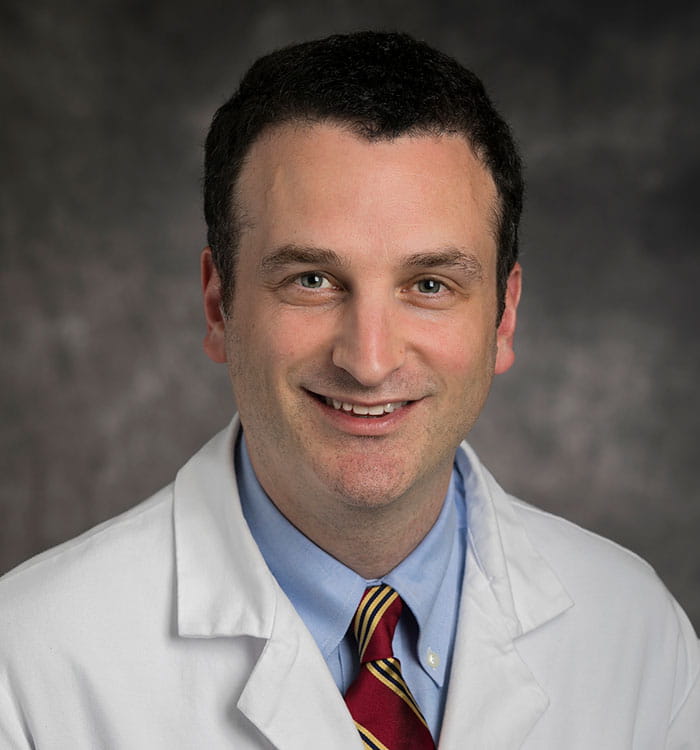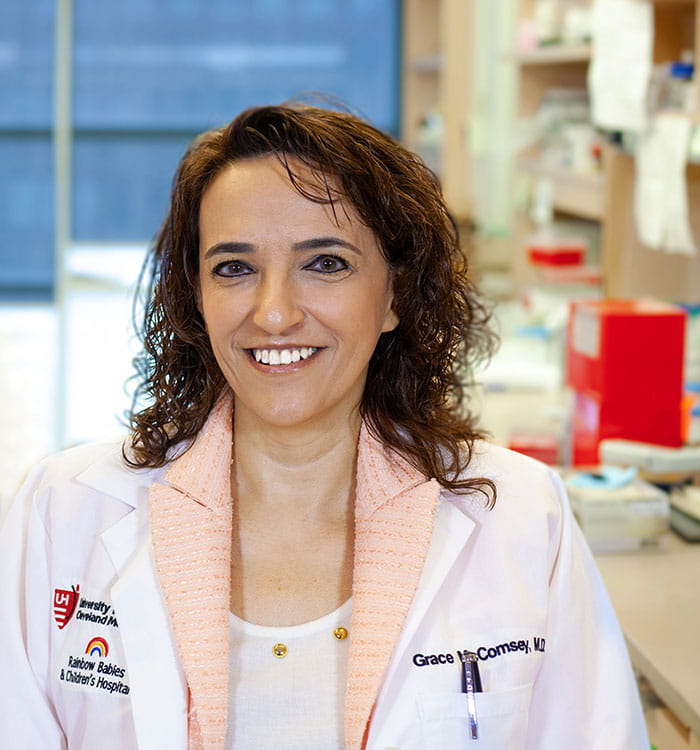How Does COVID-19 Affect Children?
November 09, 2020

Researchers at UH Rainbow involved in local, national and global efforts to further understanding
Innovations in Pediatrics | Fall 2020
Since the early days of the COVID-19 pandemic, infectious disease, hospitalists and critical care specialists at UH Rainbow Babies & Children’s Hospital have been engaged in research to better understand how the novel coronavirus affects children, with efforts locally in Cleveland and with collaborations around the world.
 Steven Shein, MD
Steven Shein, MDOne such effort grew out of an international study of bronchiolitis in PICU patients begun in September 2019 by a UH Rainbow doctor and two other members of the Pediatric Acute Lung Injury and Sepsis Investigators (PALISI) research network. Dubbed the BACON (Bronchiolitis And CO-detectioN) study, it seeks to quantify how often children with bronchiolitis also carry bacteria on top of the virus that usually causes the condition.
“When the BACON study first started, we were hoping to get about five or six centers from PALISI that would join us,” says Steven L. Shein, MD, Division Chief of Pediatric Critical Care Medicine at UH Rainbow, and Associate Professor of Pediatrics at Case Western Reserve University School of Medicine, and one of BACON’s founding investigators. “It got a little bit bigger than that. For BACON, we are now up to 111 sites: 25 in the U.S. and Canada, eight in Europe and Asia and 78 in Central and South America.”
When COVID-19 hit in early 2020, Dr. Shein says, he and the other BACON co-leaders mobilized this global network to launch a coronavirus study in children, looking specifically at severe cases that required a stay in the PICU.
“The CAKE (Critical Coronavirus and Kids Epidemiologic) study was designed to specifically investigate severe cases and provide detailed data,” Dr. Shein says. “It now involves over 65 centers in nearly 20 countries from the Americas and Europe and more than 200 patients.”
CAKE investigators published data from their first 17 cases in the journal Pediatrics in June 2020. For Dr. Shein, the data, while very early, pose some interesting possibilities.
“It's hard to draw from conclusions from 17 patients, but it appears we may have described some of the first patients with multisystem inflammatory syndrome in children (MIS-C),” he says. “There were four patients who had GI symptoms and then had heart failure while they were in the hospital, which is basically the classic combination that we see in severe MIS-C.”
Dr. Shein and his colleagues are continuing to collect data from PICU patients with COVID-19, even though the CAKE study itself has no external funding support.
“This study is completely unfunded,” he says. “It's just being done by caring and concerned ICU doctors across the world, who are giving their time to collect this data. But there's still a lot to be learned. Hopefully once we get a big enough a number of patients in the database, we might be able to even start to see whether children who get treated differently with different medications, whether that's associated with different outcomes.”
The effort has come a long way since its genesis in September 2019.
“A sort of fluky conversation between three pediatric ICU doctors last September has led to a global research program studying not just bronchiolitis, but also a novel coronavirus causing a global pandemic,” Dr. Shein says.
 Amanda Lansell, MD
Amanda Lansell, MDAt the same time that Dr. Shein has been working with international colleagues on severe COVID-19 in kids, he and his UH Rainbow colleague Amanda Lansell, MD, a pediatric hospitalist and Assistant Professor of Pediatrics at the School of Medicine, have been collaborating with fellow pediatric intensivists, hospitalists, and other specialists across the U.S. to better understand COVID-19 and the more recently identified related condition, MIS-C. Dr. Lansell was a co-author of an important early surveillance study on MIS-C published in The New England Journal of Medicine in June 2020. It reported data on 186 MIS-C patients in 26 states.
“The one thing that I think we can say from this published surveillance study is that MIS-C tends to affect school-age children, which was a little bit of a surprise because Kawasaki disease, to which it is similar, tends to affect toddlers,” Dr. Lansell says. “Based on early studies, school-age children are unlikely to be hospitalized or die from acute COVID, but they appear to be most at risk for MIS-C, at least based on this early data.”
Work to untangle the considerable mysteries of MIS-C continues, she says.
“This is an ongoing study,” she says. “We are still actively bringing patients into the repository for the surveillance study. We have hundreds of patients whom were are collecting data from across the country to try to learn more about this. The hope is to try to identify which patients are most at risk of MIS-C and which treatments work best. We are continuing to do sub-studies on the initial group and ongoing studies as we find out more about these patients. We are looking at children with serious illness who ended up in the ICU, kids with severe neurologic symptoms of MIS-C, children who require extracorporeal membrane oxygenation (ECMO), children who receive immunomodulator therapy. There’s a lot of ongoing data analysis based off of the ongoing data collection.”
 Grace McComsey, MD
Grace McComsey, MDLocally in Cleveland, University Hospitals is also building its own database and biologic samples for COVID-19 research. Led by Grace McComsey, MD, Division Chief of Pediatric Infectious Disease at UH Rainbow and Vice President of Research at University Hospitals Heath System, the COVID-19 biorepository is currently enabling more than 130 ongoing studies into different aspects of COVID-19. Dr. McComsey is also Professor of Pediatrics and Medicine at the School of Medicine.
Although the studies enabled by the UH COVID-19 biorepository are not exclusive to children, there are several issues of interest for the pediatric population, Dr. McComsey says.
“There are several embedded studies within the biorepository looking to see if we can understand COVID and kids, how it affects the immune system and how much virus they shed, if any,” she says. “We're trying to get samples on every pediatric patient we have and try to understand the effects of COVID, not just acutely, but also at three, six, nine, 12 months after the diagnosis to see how the immune system disturbances and inflammation that we see during the acute illness translate over the long term.”
According to Dr. McComsey, this is a bit of a sleeper issue in COVID-19 research. One of her areas of research is the inflammatory effects of HIV, which may have some parallels with COVID-19.
“People tend to ignore pediatric COVID to a large part because they feel most kids will do fine,” she says. “But if we discover that even those who do ‘fine’ end up with high inflammation or disturbances in their immune system that seem to last beyond the acute phase of the illness, that will open up a lot of concerns and a need for a lot of potential research avenues for pediatric COVID.”
“Chronic, long-term inflammation can really have bad effects, even worse on kids than on adults,” she adds. “If we show that kids with COVID have long-term disturbances in their immune system and long-term heightened systemic inflammation, then we would need to clarify whether these children may be predisposed to not only other infections if that immune system is disturbed, but also to the effect of chronic inflammation, potentially comorbidities like diabetes or premature heart disease.”
Scenarios like these point to the need for continued research into COVID-19 and kids, both at UH Rainbow and around the world, Dr. McComsey says.
“We assume always that kids are same than adults, but that’s not the case,” she says. “It’s so important to check all the angles -- biologic, immunologic, genetic. There's a lot of studies happening here to better understand what’s happening with COVID and kids.”
For more information on UH Rainbow Babies & Children’s Hospital’s role in ongoing COVID-19 pediatric research, email Peds.Innovations@UHhospitals.org.


